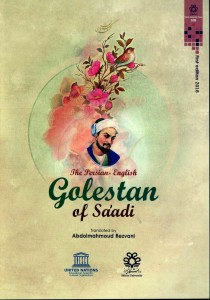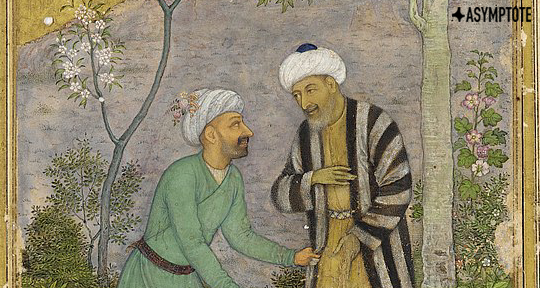In comparing various translations of the same text, one considers several factors—amongst them: accuracy, consistency, and the ease in which the secondary text reads in its newfound state. New translations of classic texts are further expected to provide knowledge and profundity that other extant translations missed. The writings of Persian poet Sa’di are intimately known and cherished in his original language, but its multiple iterations in English have each developed separate and, at times, misleading voices. In this following essay, writer and translator Siavash Saadlou discusses Mahmoud Rezvani’s new translation of Sa’di’s timeless Golestan, and how Rezvani’s insight into the book and his aptitude for translation have allowed his work to rise above its predecessors.

Yet Sa’di loved the race of men,—
No churl, immured in cave or den
In bower and hall, he wants them all,
Nor can dispense
With Persia for his audience;
They must give ear,
Grow red with joy and white with fear;
But he has no companion;
Come ten, or come a million,
Good Sa’di dwells alone.—Ralph Waldo Emerson
Mahmoud Rezvani’s new translation of Sa’di’s Golestan—a thirteenth-century literary lighthouse best known for its creative composition, moralistic maxims, and lush language—challenges the notion suggesting that fidelity and beauty are mutually exclusive in literary translation. When Rezvani, now in his mid-sixties, proposed the idea for the first time, the literati in Iran thought it “preposterous” and “impossible.” Their deeply held cynicism was derived in part from Golestan’s ornate Persian, mixed with bombastic Arabic and Qur’anic allusions, that render its prose and poetry extraordinarily labyrinthine. It also stemmed from Sa’di’s shrewd use of ambiguities and amphibologies as well as heteronyms and homographs throughout the work; and Sa’di’s rhymed prose (Saj’)—which can be divided into three categories: parallel, symmetrical, and lopsided—made the task ahead all the more formidable. Choosing le mot juste was yet another major hurdle to overcome. Sa’di was, after all, a writer best known for his impeccable, inimitable turn of phrase. His command over both Persian and Arabic was beyond compare; in fact, Sa’di was as recognized for his mastery of language as Hafiz was for his consummate ambiguity. The difficulty, therefore, lay in translating Sa’di’s wide palette of vocabularies as well as the supremely intriguing juxtaposition of images and ideas. Then there was the musicality which, though often ignored in Western translations, is the lifeblood of classical Persian literature. It is understandable, then, that it took Rezvani years to pluck up the courage to even consider translating Golestan and ten years to complete the endeavor. READ MORE…




A Pointed Atemporality: Mui Poopoksakul on Translating Saneh Sangsuk’s Venom
He's very aware of the rhythm and musicality of this text . . . he said it should take something like an hour and thirty-seven minutes to read.
In our May Book Club selection, a young boy struggles with a snake in the fictional village of Praeknamdang, in a tense battle between beauty and cruelty. In poetic language that is nostalgic for the world it describes without romanticizing it, Saneh Sangsuk creates a complex and captivating world. In this fable-like story there are no simple morals, in keeping with Sangsuk’s resistance to efforts to depict a sanitized view of Thailand and to the idea that the purpose of literature is to create a path to social change. In this interview with translator Mui Poopoksakul, we discuss the role of nature in the text, translating meticulous prose, and the politics of literary criticism.
The Asymptote Book Club aspires to bring the best in translated fiction every month to readers around the world. You can sign up to receive next month’s selection on our website for as little as USD20 per book; once you’re a member, join our Facebook group for exclusive book club discussions and receive invitations to our members-only Zoom interviews with the author or the translator of each title.
Barbara Halla (BH): How did you get into translation, especially given your law background?
Mui Poopoksakul (MP): I actually studied comparative literature as an undergrad, and then in my early twenties, like a lot of people who study the humanities, I felt a little bit like, “Oh, I need to get a ‘real job.’” I went to law school, and I worked at a law firm for about five years, and I liked that job just fine, but it just wasn’t what I wanted to do for the rest of my life.
So, I started thinking, What should I be doing? What do I want to do with myself? I had always wanted to do something in the literary field but didn’t quite have the courage, and I realized that not a lot of Thai literature been translated. I thought, If I can just get one book out, that would be really amazing. So, I went back to grad school. I did an MA in Cultural Translation at the American University of Paris, and The Sad Part Was was my thesis from that program. Because I had done it as my thesis, I felt like I was translating it for something. I wasn’t just producing a sample that might go nowhere.
The whole field was all new to me, so I didn’t know how anything worked. I didn’t even know how many pages a translation sample should be. But then I ended up not having to worry about that because I did the book as my thesis.
BH: You mentioned even just one book, but did you have any authors in mind? Was Saneh Sangsuk one of those authors in your ideal roster?
MP: I wouldn’t say I had a roster, but I did have one author in mind and that was Prabda Yoon, and that really helped me get started, because I wasn’t getting into the field thinking, “I want to translate.” My thought was, “I want to translate this book.” I think that helped me a lot, having a more concrete goal.
READ MORE…
Contributor:- Barbara Halla
; Languages: - English
, - Thai
; Place: - Thailand
; Writers: - Mui Poopoksakul
, - Prabda Yoon
, - Saneh Sangsuk
; Tags: - Deep Vellum
, - environmentalism
, - literary criticism
, - nature
, - nature in storytelling
, - pacing
, - pacing in translation
, - Peirene
, - respect for nature
, - rhythm
, - rhythm in translation
, - social commentary
, - storytelling
, - Thai literature